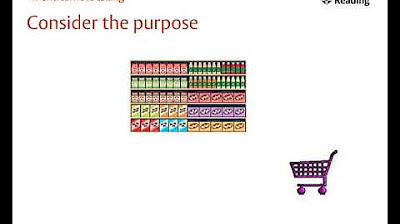Prise de note - La méthode C-O-D-E
Summary
TLDREffective note-taking is crucial for retaining and organizing information. The 'Code Matrix' method, introduced by Thiago Forte, breaks down the note-taking process into four steps: Capture, Organize, Distill, and Express. By using tools like Word, Notion, or even paper, notes can be structured for better understanding. Additional tips like noting page numbers or timecodes make future reference easier. This method helps transform raw notes into actionable knowledge, making it a valuable strategy for students and knowledge workers alike.
Takeaways
- 😀 Taking effective notes is not something we are formally taught in school, despite its importance in learning and knowledge retention.
- 📝 The C.O.D.E. matrix is an efficient system for improving note-taking: Capture, Organize, Distill, and Express.
- 📚 Capture: Take concise notes during lectures, readings, or videos, ensuring they are understandable without the original context.
- 🔄 Organize: Group the notes by themes based on your understanding, not necessarily following the course structure.
- 💡 Distill: Review each note and place it under a relevant theme, making sure it fits logically within your understanding of the subject.
- ✍️ Express: Summarize and explain what you've learned in your own words, as if teaching it to someone else (even a child).
- 📱 Digital tools like Word, Notion, or Obsidian are ideal for organizing notes and linking ideas, making them more accessible and easier to manage.
- 🖊️ Paper and pen can be valuable for situations where you prefer not to use digital tools, such as when reading at night or sketching concepts.
- 📱 Tablets provide a good balance between digital and handwritten notes, allowing you to combine both methods in one device.
- 🔖 A helpful tip when taking notes from books or videos is to note the page number or timestamp for quick reference later on.
- 📋 Keep extra notes in a toggle list to ensure you can expand or revisit them without cluttering your main notes.
Q & A
What is the Code Matrix method for note-taking?
-The Code Matrix is a four-step process for effective note-taking, developed by Thiago Forte. The four steps are: Capture (taking initial notes), Organize (sorting notes into themes), Distill (refining and categorizing notes), and Express (rewriting notes in your own words to ensure understanding).
What is the purpose of the Capture step in the Code Matrix method?
-The purpose of the Capture step is to quickly write down notes during lectures, conferences, or while reading. The goal is to capture key information concisely, including references (like page numbers or timecodes) for easy context retrieval later.
How does the Organize step help with note-taking?
-In the Organize step, you arrange the notes into a structure that makes sense to you, grouping them into themes. This helps you understand the subject better by creating an overview, regardless of the original structure of the course or book.
What is the purpose of the Distill step, and how does it work?
-The Distill step involves refining and sorting your notes into specific themes. Some notes may belong to multiple themes, but the goal is to create clarity by breaking down the notes into more organized, focused categories.
What does the Express step entail, and why is it important?
-The Express step involves rewriting your notes in your own words to ensure a deep understanding of the material. By explaining the concepts as if teaching someone else, you solidify your comprehension and ensure you're able to articulate the information clearly.
What tools are recommended for effective note-taking?
-Digital tools like Word, Notion, or Obsidian are recommended because they allow you to capture, organize, and distill notes in one place, while also enabling the creation of links between notes. However, pen and paper are good alternatives when quiet or offline environments are required.
Why is it important to note references (such as page numbers or timecodes) during note-taking?
-Noting references like page numbers or timecodes helps you return to the original source for more context if needed. It also helps you avoid losing track of the specific information and its context, especially when reviewing notes later.
How can a toggle list enhance your note-taking process?
-A toggle list allows you to hide or reveal notes, making it easier to organize and access information without cluttering your workspace. This technique helps keep your notes tidy while still maintaining access to additional details for future reference.
What are the advantages of using a tablet for note-taking?
-A tablet offers a good compromise as it combines the benefits of both digital and manual note-taking. It allows you to capture written notes and type them up in the same tool, providing flexibility and a streamlined process.
Why is it important not to delete notes during the note-taking process?
-Not deleting notes allows you to preserve all information for future review. Even if a note seems unimportant at first, it could be valuable later. Keeping notes accessible ensures you don't lose important context or ideas that may be useful for deeper understanding.
Outlines

هذا القسم متوفر فقط للمشتركين. يرجى الترقية للوصول إلى هذه الميزة.
قم بالترقية الآنMindmap

هذا القسم متوفر فقط للمشتركين. يرجى الترقية للوصول إلى هذه الميزة.
قم بالترقية الآنKeywords

هذا القسم متوفر فقط للمشتركين. يرجى الترقية للوصول إلى هذه الميزة.
قم بالترقية الآنHighlights

هذا القسم متوفر فقط للمشتركين. يرجى الترقية للوصول إلى هذه الميزة.
قم بالترقية الآنTranscripts

هذا القسم متوفر فقط للمشتركين. يرجى الترقية للوصول إلى هذه الميزة.
قم بالترقية الآن5.0 / 5 (0 votes)






